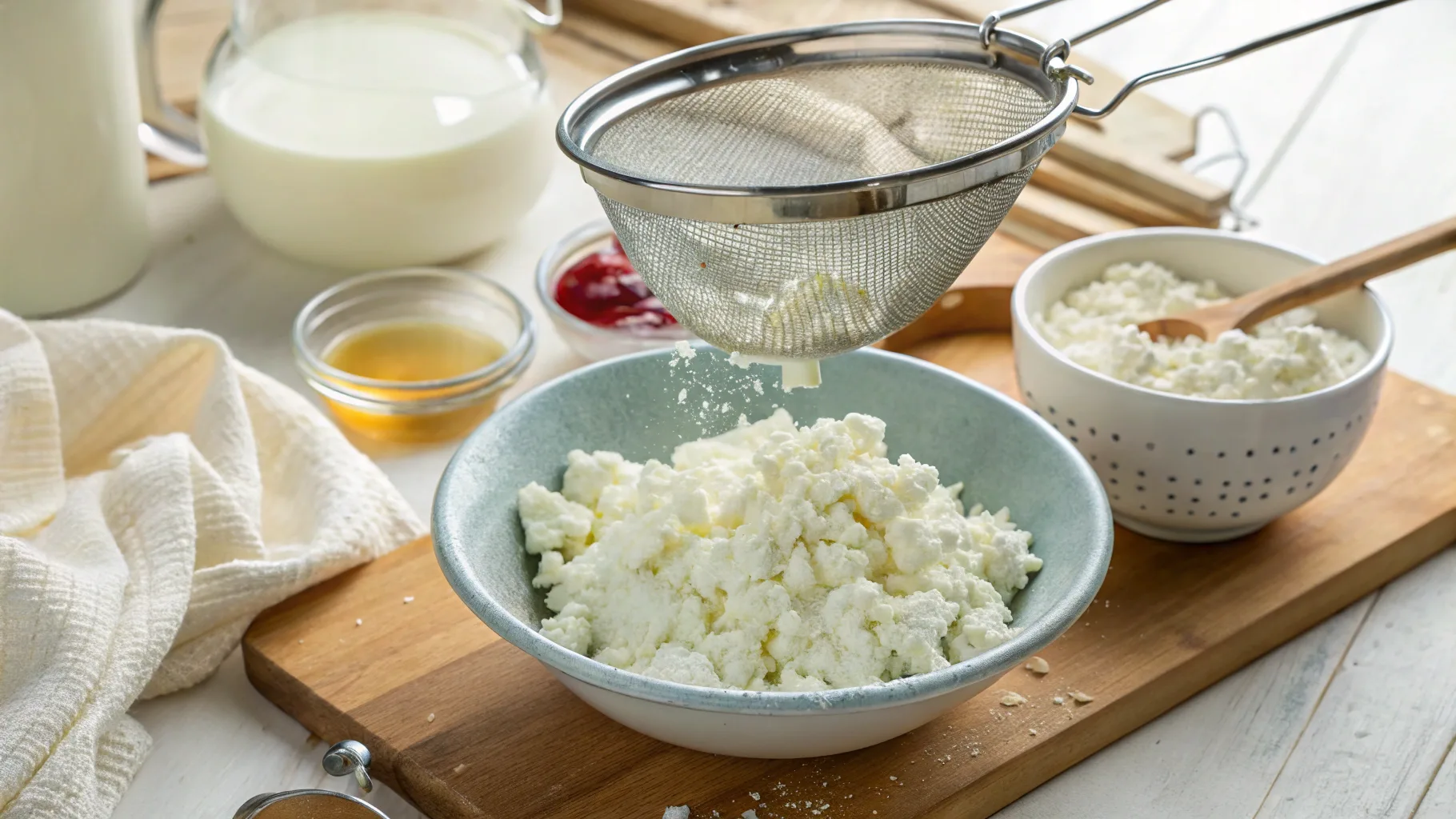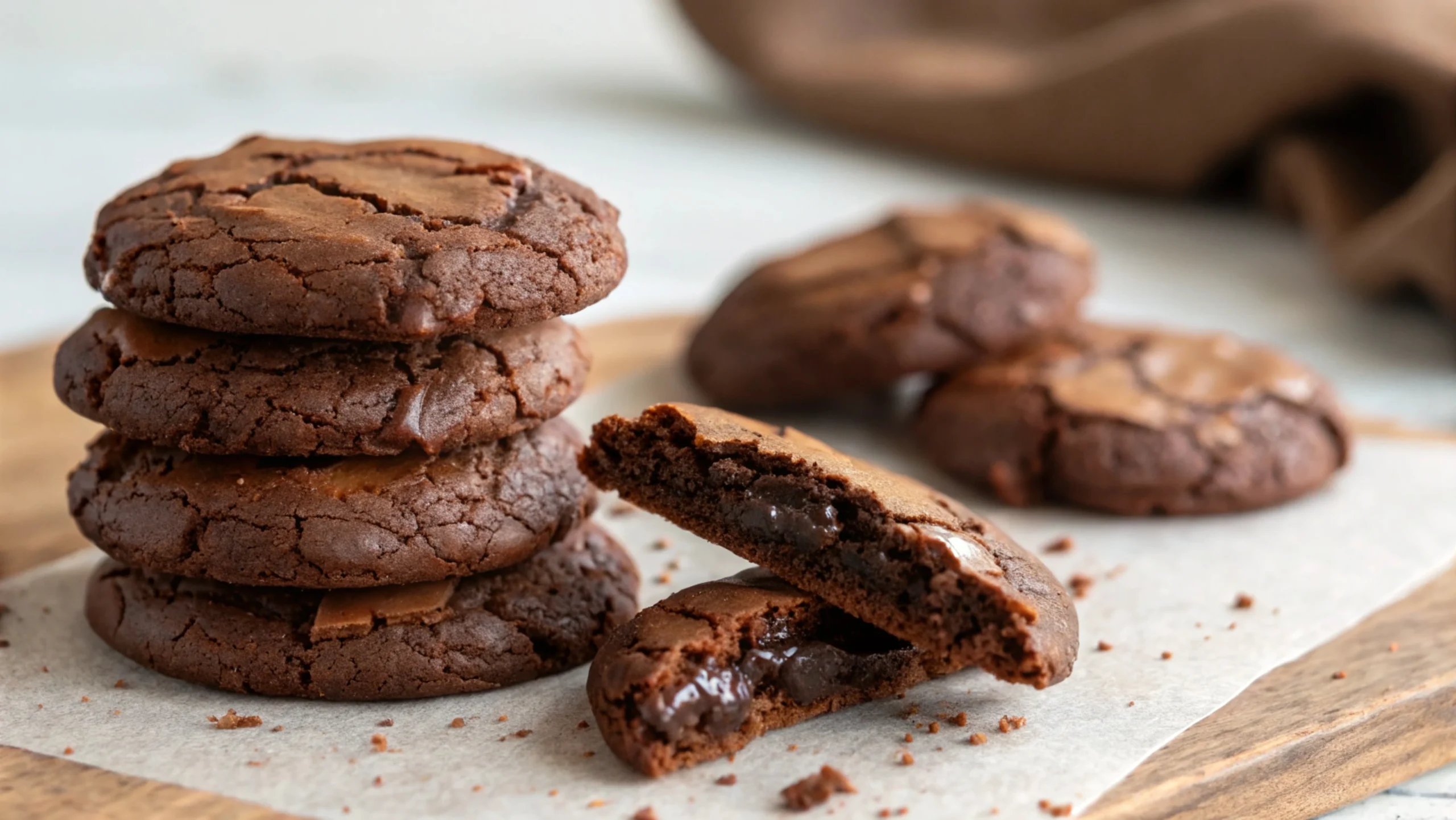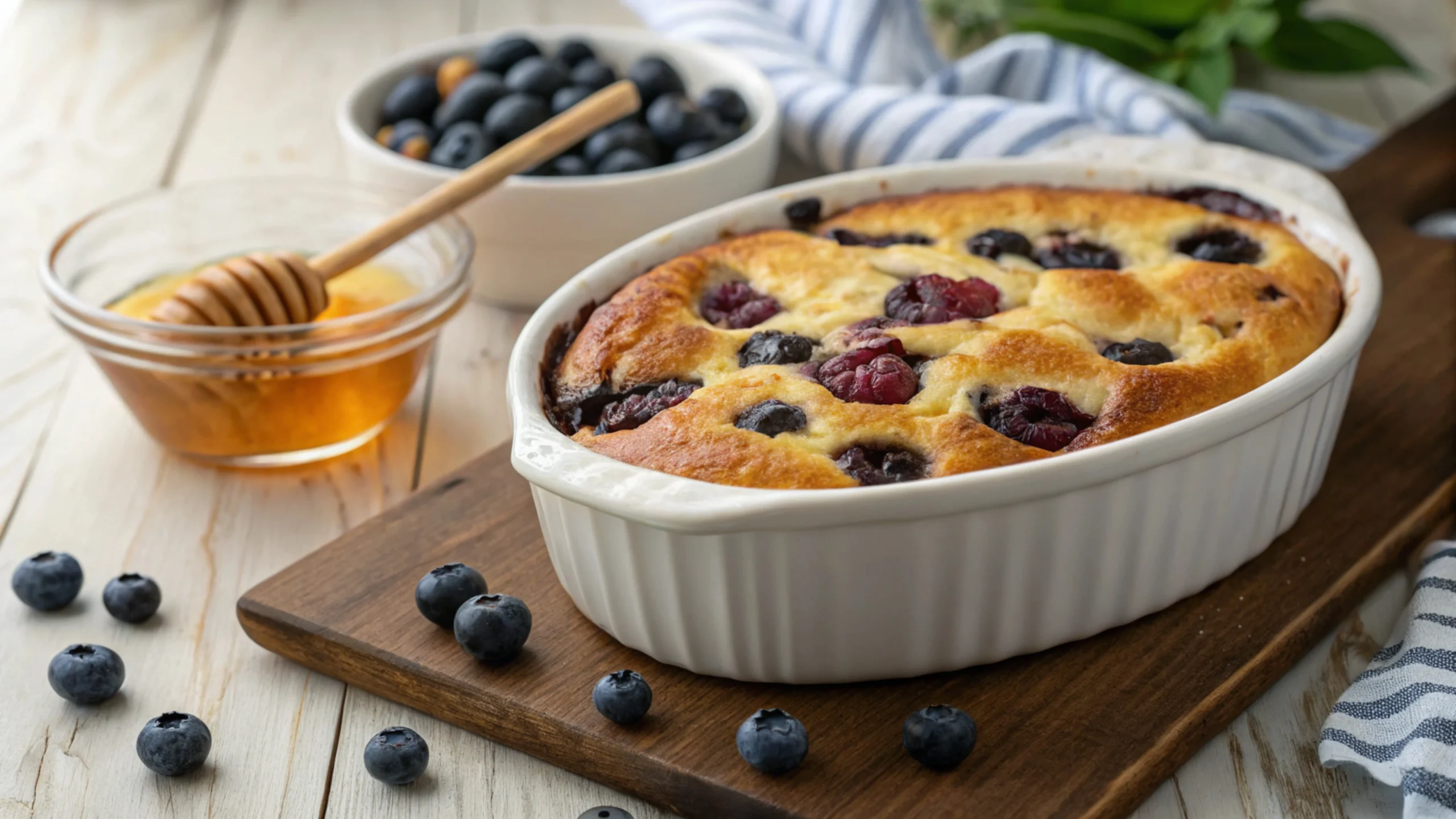Introduction
Cottage cheese is a versatile and nutritious ingredient used in a variety of dishes, from creamy dips to hearty lasagnas. However, its high moisture content can sometimes pose challenges, especially if you need a firmer or drier consistency for your recipe. Learning how to drain cottage cheese properly is an essential skill. Whether you’re aiming for a smoother spread or reducing liquid to avoid a watery dish, Draining cottage cheese to remove excess liquid is an easy and straightforward task.
In this comprehensive guide, we’ll explore multiple methods to Strain cottage cheese, discuss the benefits of doing so, and provide creative uses for your perfectly prepared ingredient. By the end, you’ll have everything you need to achieve the perfect consistency for any recipe.
If your cottage cheese seems overly watery, you might also want to check out how to make cottage cheese less watery, a guide packed with practical solutions.
Table of contents
Why Remove Liquid from Cottage Cheese?
Cottage cheese contains a mixture of curds and whey, giving it a naturally wet texture. While this is perfect for some recipes, it can be less desirable for others. Here’s why you might want to drain it:
- Thicker Texture for Recipes
When you drain cottage cheese, it becomes creamier and firmer, making it ideal for spreads, fillings, or toppings. - Improved Cooking Results
Draining cottage cheese helps reduce moisture, preventing soggy layers in baked dishes like lasagna. - Better Integration into Desserts
Many recipes, such as cheesecakes or parfaits, require a smooth and consistent base. - Customizable Consistency
You can tailor the texture of cottage cheese to suit your specific needs, whether for dips, salads, or baking.
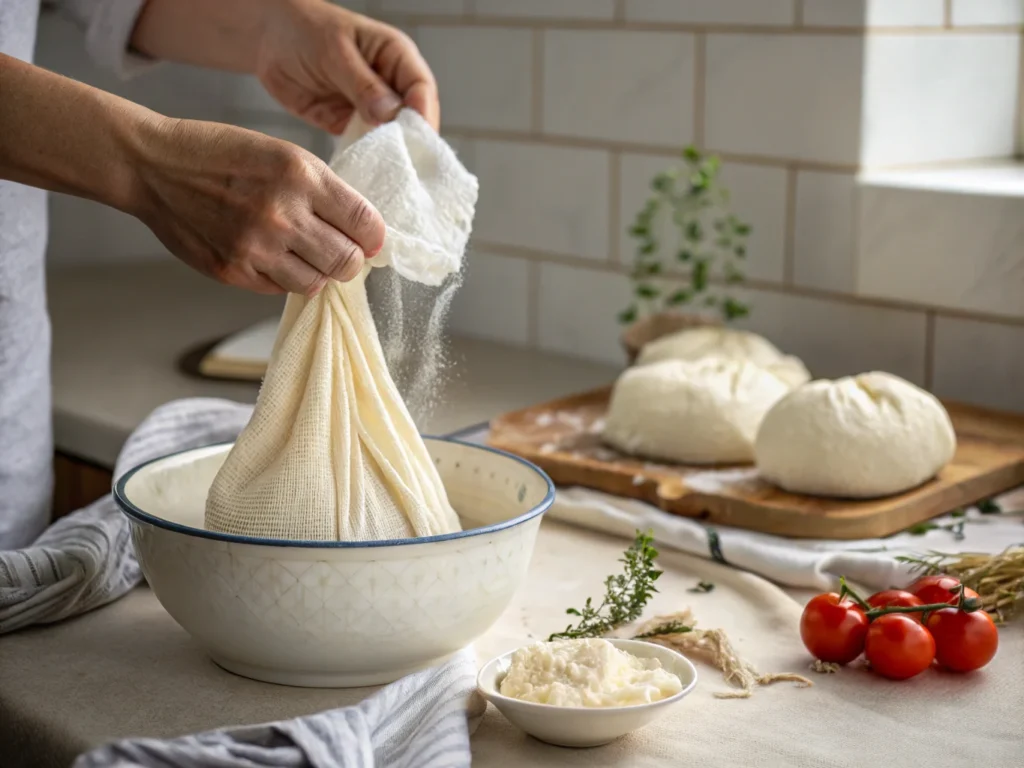
Methods to Remove Liquid from Cottage Cheese
Below are four tried-and-true methods for draining cottage cheese, each suited to different needs and equipment. Follow these steps to achieve the perfect consistency for your recipes.
1. Using a Fine-Mesh Strainer or Sieve
This method is quick, effective, and a simple way to drain cottage cheese with minimal tools.
- Place a fine-mesh strainer or sieve over a large bowl.
- Pour the cottage cheese into the strainer to drain the excess liquid thoroughly.
- Allow the liquid (whey) to drip into the bowl naturally.
- To speed things up, gently shake or stir the cottage cheese with a spoon.
- Let it sit for 10-15 minutes or until you achieve the desired dryness.
Best For: Everyday recipes or small batches.
2. Using Cheesecloth for Thorough Draining
Cheesecloth is a popular choice to drain cottage cheese thoroughly.
- Line a bowl or colander with a double layer of cheesecloth.
- Spoon the cottage cheese into the center of the cloth.
- Gather the edges to form a bundle and twist the top to secure it.
- Hold the bundle over the sink and gently squeeze to release the liquid.
- Hang the cheesecloth bundle over a bowl to fully drain cottage cheese, ensuring it reaches the desired dryness.
Best For: Recipes needing very dry cottage cheese, like cheesecakes or spreads.
3. Pressing with a Weight
For those who want a hands-free method, pressing is a great option.
- Transfer the cottage cheese into a fine-mesh strainer or cheesecloth-lined colander.
- Place a small plate or flat object on top of the cottage cheese to drain it more effectively.
- Add a weight (such as a heavy can or jar) on top of the plate to press out liquid.
- Let it sit for 15-30 minutes to drain thoroughly.
Best For: Large batches or when multitasking.
4. Absorbing Liquid with Paper Towels
If you’re in a hurry or working with a small amount of cottage cheese, paper towels are a convenient option.
- Spread several layers of paper towels on a flat surface or plate.
- Scoop the cottage cheese onto the paper towels.
- Place another layer of paper towels on top and press lightly to absorb the liquid.
- Replace the towels as needed until the cheese reaches the desired consistency.
Best For: Quick fixes or small portions.
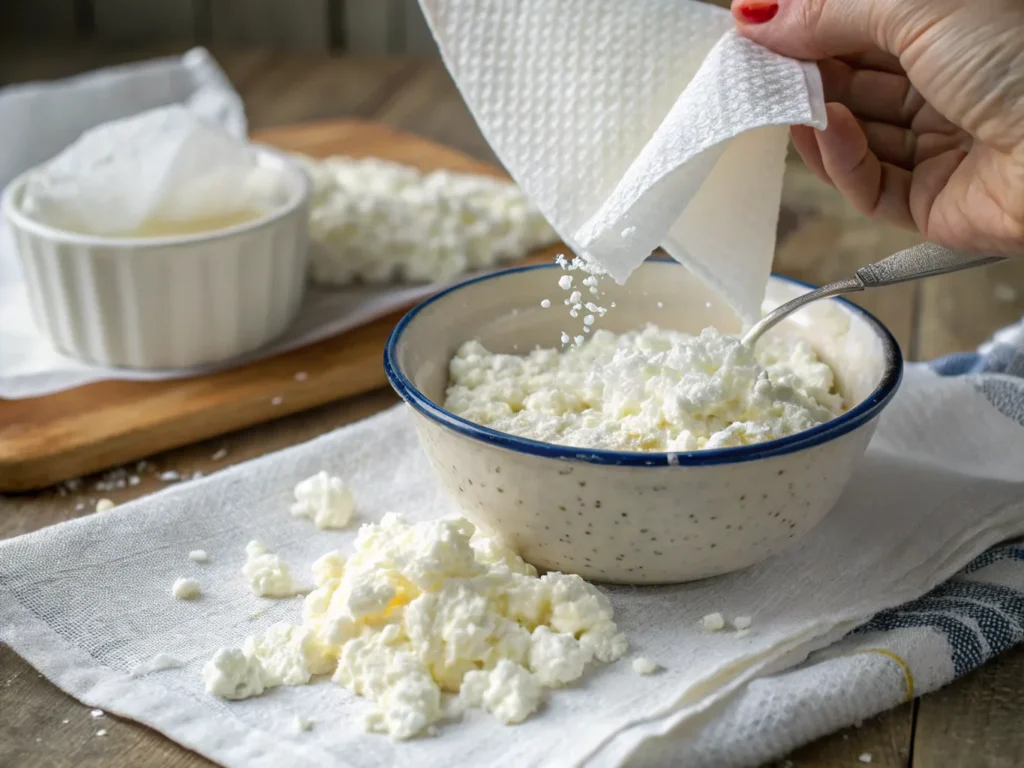
Advanced Tips for Draining Cottage Cheese Successfully
- Don’t Over-Strain: Removing too much liquid can make the cheese dry and crumbly, which may not suit all recipes. For recipes like dips or spreads, leaving a bit of moisture can enhance creaminess and flavor.
- Save the Whey: The liquid you drain off is nutrient-rich and can be used in smoothies, soups, or baked goods. It contains protein and vitamins, making it a valuable ingredient for reducing food waste while boosting your recipes.
- Adjust Time Based on Need: For quick recipes, a short drain might suffice, while more complex dishes benefit from thorough straining. Experiment with different drainage times to find the perfect consistency for each type of dish. For instance, desserts like cheesecakes often require a drier texture, while salads may need slightly moist cottage cheese.
- Experiment with Flavors: Drained cottage cheese can be blended with herbs, spices, or fruits for unique flavor profiles. Consider adding dill, chives, or garlic for savory applications, or mix in honey and berries for a sweet treat.
- Use the Right Tools: Ensure that you’re using high-quality tools like a fine-mesh sieve or durable cheesecloth for consistent results. Investing in the right kitchen tools can make the process faster and more efficient, especially for frequent use.
- Store Drained Cheese Properly: Once drained, transfer your cottage cheese to an airtight container and refrigerate it. This helps maintain its freshness and prevents it from drying out too much. Drained cottage cheese can typically last for up to three days in the fridge.
- Test with Small Batches First: If you’re new to draining cottage cheese, start with smaller quantities to perfect your technique. This way, you minimize waste while learning how to achieve the texture you need.
- Combine Methods for Maximum Efficiency: Sometimes, combining techniques, such as pressing with a weight and then absorbing remaining moisture with paper towels, can yield faster and more consistent results.
Creative Uses for Drained Cottage Cheese
Once you’ve successfully drained cottage cheese, here are a few ways to use it:
- Creamy Cheesecakes – Drained cottage cheese blends smoothly into batter for a light yet creamy dessert.
- Hearty Lasagnas – Reduce sogginess by layering drier curds with sauce and noodles.
- Whipped Spreads – Combine drained cottage cheese with herbs and spices for a flavorful spread.
- Smooth Parfaits – Layer drained cottage cheese with fresh fruits and granola for a healthy treat.
- Protein-Packed Snacks – Mix drained cottage cheese with peanut butter or honey for a satisfying snack.
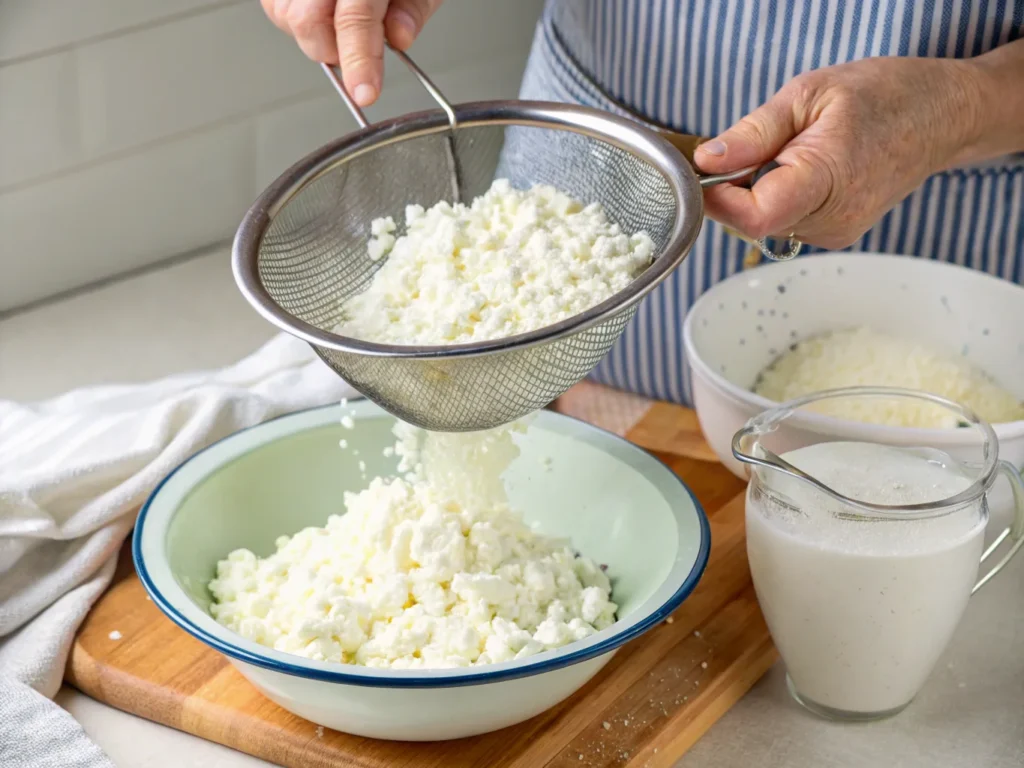
Nutritional Benefits of Cottage Cheese
Cottage cheese is not just versatile; it’s also incredibly healthy, offering numerous nutritional benefits that make it a fantastic addition to a balanced diet. By draining it, you retain the rich protein and calcium content, both of which are essential for muscle health, bone strength, and overall well-being. The protein in cottage cheese is primarily casein, a slow-digesting protein that keeps you feeling full for longer, making it an ideal choice for weight management and muscle recovery after workouts.
In addition to its protein and calcium, cottage cheese is naturally low in calories, making it an excellent option for weight-conscious individuals or anyone looking to maintain a healthy lifestyle. It’s also a good source of important nutrients like vitamin B12, phosphorus, and selenium, which support energy production, cell repair, and a healthy immune system. The low fat and carb content in most varieties make it suitable for those following low-carb or ketogenic diets.
Draining cottage cheese further enhances its usability in recipes, as it removes excess whey without compromising the nutrient profile. This makes it easier to incorporate into a variety of dishes, from savory meals like lasagna or salads to sweet treats like cheesecakes and parfaits. Whether you’re seeking a snack that fuels your body or a versatile ingredient to enrich your cooking, cottage cheese checks all the boxes.
Looking for ways to use perfectly drained cottage cheese? Here are some ideas to spark creativity:
- Baked Cottage Cheese Recipes: Dry cottage cheese works wonderfully in baking. Explore this baked cottage cheese recipe for inspiration.
- Flatbreads and Dough: A firmer consistency is ideal for creating less soggy cottage cheese flatbread.
FAQs
1. How to make cottage cheese less watery?
To make cottage cheese less watery, you can try draining it more thoroughly. One simple method is to To drain cottage cheese and make it less watery, place it in a fine-mesh sieve over a bowl and let the excess liquid drip out for about 30 minutes. This will allow excess liquid to drain out. You can also press gently to help remove additional moisture. If the cottage cheese still feels too watery, you can try using a paper towel to absorb some of the liquid.
2. How do you drain cottage cheese without cheesecloth?
If you don’t have cheesecloth, you can use a fine-mesh strainer or a colander with small holes. Place the cottage cheese into the strainer and let it sit over a bowl for about 15-30 minutes. Press down gently with the back of a spoon to help release the liquid. Another option is using a clean kitchen towel or paper towels to gently blot away the excess moisture.
3. Why is there so much liquid in my cottage cheese?
The liquid in cottage cheese is usually a byproduct of the curdling process. It forms because the curds are separated from the whey (the liquid). Some cottage cheeses have higher moisture content depending on the brand and the process used. Additionally, cottage cheese can release more liquid if it’s been stored improperly or if it’s made with higher-fat milk.
4. Should you rinse cottage cheese?
Rinsing cottage cheese is not always necessary, but it can help remove some of the excess liquid and reduce its saltiness. If you find the taste or texture too tangy, a quick rinse under cold water can make it milder. However, if you enjoy the creaminess and slightly tangy flavor, rinsing may not be needed. It depends on personal preference!
Final Thoughts
Addressing watery cottage cheese is simple when you know how to drain cottage cheese effectively and achieve the ideal texture. Whether you’re preparing it for a recipe or exploring its many uses, properly prepared cottage cheese is a game-changer. Don’t forget to browse our other related articles, such as does cottage cheese melt when baked to expand your culinary knowledge.
For more tips on using cottage cheese in creative ways, check out our other culinary guides!

